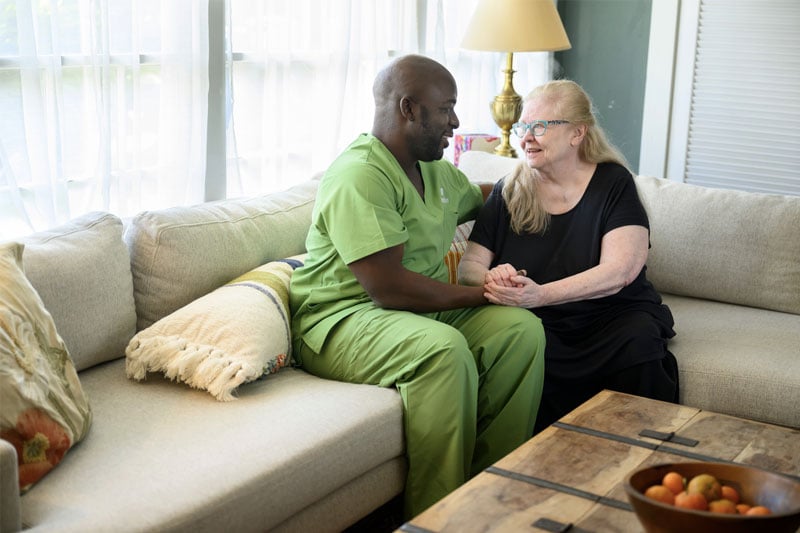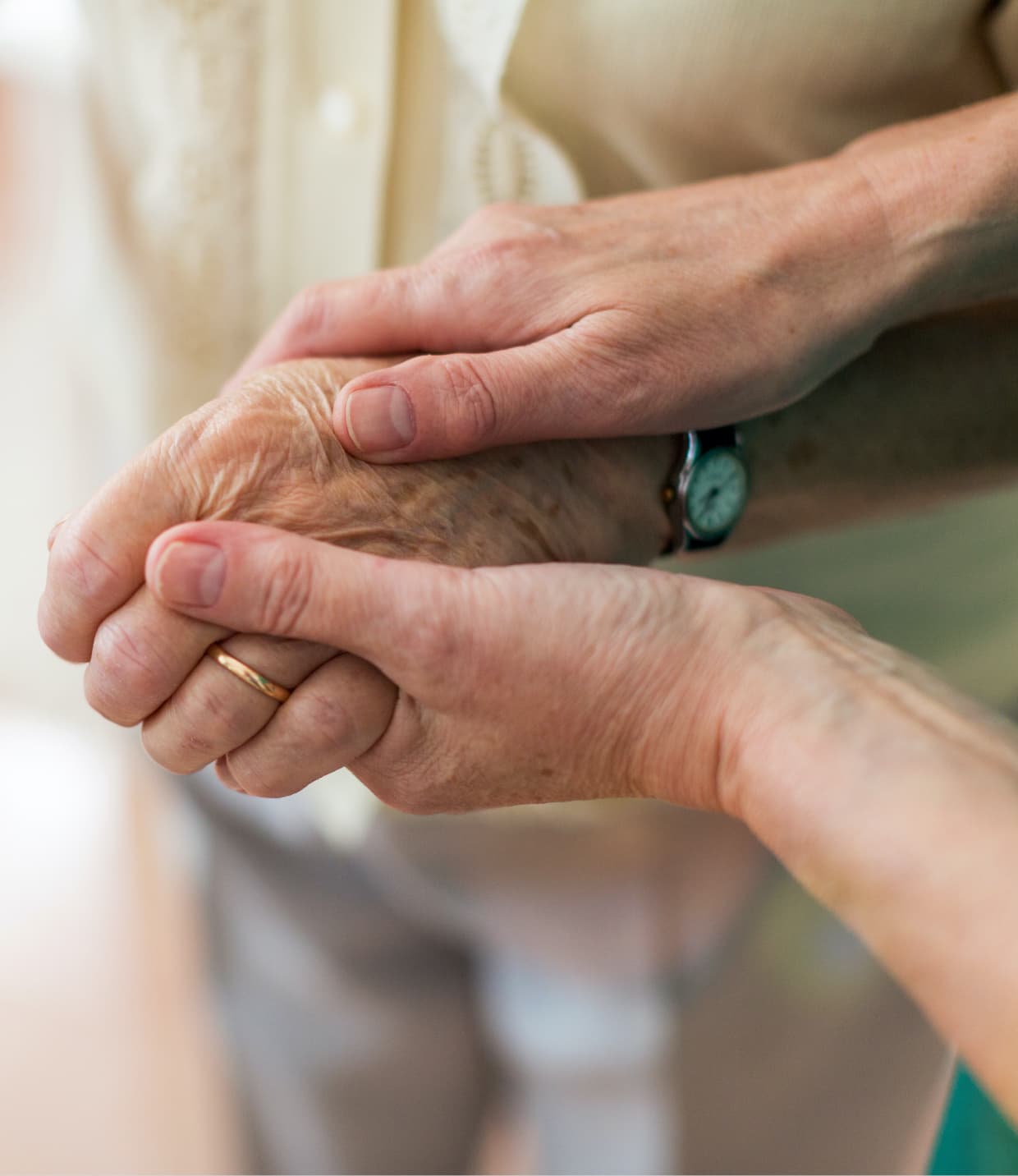What is hospice, really? Many people facing a life-limiting illness— or supporting a loved one who is— struggle with this very question. Despite its vital role in end-of-life care, hospice is often misunderstood. This blog dives into the hospice care truth, shedding light on what hospice truly provides: comprehensive physical, emotional, psychosocial and spiritual support for both patients and their families.
If your family is facing a decision as to whether hospice care is the answer, you may be confronted with misconceptions about what hospice is and isn’t. We’ll walk through the four levels of hospice care and share ten things you may not know about how hospice works.
What is Hospice Care?
Hospice care is defined as supportive care that focuses on comfort and quality of life for patients with a terminal illness and a life expectancy of six months or less, as certified by a physician. The goal of hospice care is comfort and quality of life rather than pursuing aggressive, curative treatments.
An interdisciplinary team of hospice clinicians includes physicians, nurses, aides, social workers, chaplains and more. This team works together to provide care wherever the patient calls home and to guide the patient and their family through the end-of-life journey.
Hospice Myths and Facts: Ten Truths You May Not Know
1. Hospice is not giving up
Some may view entering hospice as giving up or even hastening death. In reality, hospice helps patients focus on what really matters to them: living the best quality of life possible, sharing time with loved ones, making new memories and striving for any specific goals they may have.
Hospice care places deep value on every day of life, no matter how many remain— supporting patients in finding meaning, comfort, and dignity in each moment. By managing pain and symptoms, patients can focus on how they want to live their remaining time, restoring hope for a peaceful and meaningful experience.
2. Hospice is not just for cancer patients
Hospice care is sometimes associated with people diagnosed with cancer, but the service is available for any eligible patient with a life-limiting illness. This can include people diagnosed with heart disease, Chronic Obstructive Pulmonary Disease (COPD), lung disease, Parkinson’s disease, dementia and others. In fact, Alzheimer’s disease, dementia and COPD all outpace cancer as the top three principal diagnoses of all hospice recipients. 1 Each patient has a unique care plan tailored to their individual needs and circumstances.
3. Hospice is not a place
Hospice is a service, not a place, and is provided wherever the patient calls home. Most patients receive hospice care at their homes, offering safety, comfort and the presence of loved ones. The next largest group of patients receives care in a nursing home, skilled-care or assisted living facility. The smallest percentage receive care in a hospital, hospice center or other setting.
4. Hospice is not just for the final days or weeks
A physician certification that a patient is terminally ill means they have six months or less to live if the disease runs its normal course. Electing to enter hospice sooner rather than later ensures that symptoms are better managed, pain and psychological suffering may be minimized and that patients can enjoy the comforts of wherever they prefer to call home.
According to the latest data available, the median length of stay for hospice patients in 2022 remains only 18 days of hospice care. 2 This means that many patients miss the full benefits hospice care can provide by waiting too long to begin care.
5. Hospice provides medical care
Hospice is provided by a team of skilled clinicians, including nurses, chaplains, social workers and more, to manage pain and symptoms of the disease.
6. Hospice patients can be re-certified after six months of care
Hospice patients are not automatically discharged if they receive six months of care. If the patient lives longer than six months and still qualifies for hospice, their doctor can re-certify them to stay on hospice service. Patients and families can always elect to stop hospice care at any time, should the patient’s goals change or for any other reason.
7. Hospice care also supports caregivers
Being a caregiver for a terminally ill family member or friend can be extremely taxing. Hospice care is designed to support caregivers as well, both before and after the patient passes. For example, respite care can be available to place the patient in a facility for up to five days/five nights when caregivers need a break. The care team continues to coordinate the plan of care and arranges transport for the patient back and forth from an approved partner facility.
At Amedisys, hospice care also provides bereavement support to family and friends for up to 13 months following the death of the patient. Bereavement activities range from phone calls, individual support, memorial services, commemorative activities, holiday grief support and more.
8. Hospice is not only for the elderly
While hospice is most often associated with the elderly, it is available for anyone facing a life-limiting illness at any stage in life. Many private insurance plans follow similar eligibility guidelines to Medicare and may include a terminal diagnosis and a cessation of curative treatment.
9. Hospice does not mean losing control
Electing hospice doesn’t mean you lose control. Hospice professionals provide support, education and training so patients and families can better manage end-of-life pain and other symptoms. Hospice care is best when caregivers, friends and family are actively engaged in the care of the patient, ensuring the patient lives the rest of their life in comfort, surrounded by the ones they love.
10. Hospice is covered by Medicare
With all the help hospice offers some older adults think it’s out of their budget, but for many people there are no out-of-pocket costs. The Medicare hospice benefit offers comprehensive coverage for hospice care if the patient meets eligibility criteria. 3
Four Levels of Hospice
Medicare-certified hospice agencies provide four levels of hospice care. The type of service a patient receives under these four levels of care depends on their unique situation and care needs. It is helpful to understand the basics of the four levels when choosing hospice care:
1. Routine Home Care
The most common hospice service, routine home care allows patients to remain wherever they call home. A hospice team visits regularly and is available 24/7, providing care, equipment and supplies as needed.
2. Respite Care
For caregiver relief, respite care offers for the patient to stay up to five days/five nights in a facility with 24-hour nursing. Hospice coordinates the care and transport giving families a needed break.
3. Continuous Home Care
Provided during short-term medical crises of uncontrolled pain or other symptoms at home, this care involves at least eight hours of intensive nursing support in a day. Once the pain or symptoms are managed, the patient returns to routine care.
4. General Inpatient Care
When unmanaged pain or other symptoms can’t be managed at home, patients can be moved to a hospital or facility for more intensive care. Hospice manages the transition and ongoing plan of care, returning the patient home under routine care when pain or symptoms are managed.
Is Hospice the Answer for You?
Understanding what hospice really is— beyond the myths and misconceptions— can make all the difference when navigating care options for yourself or a loved one. Hospice offers more than end-of-life care; it provides comfort, dignity and support tailored to each patient's and family's unique needs. If you're still unsure whether hospice might be the right step, take a moment to explore your options further.
If you or your loved one is considering hospice, consider taking the Amedisys hospice quiz to find out if it’s the right answer for you. A hospice specialist will be available to answer your questions and guide you through the process.
Deb Gallaher, MBA, MSN, RN, NE-BC, CHPN, is a Senior Hospice Clinical Education Specialist for Amedisys. She has 10 years of experience in hospice and is passionate about sharing her insights on high-quality care.
rEFERENCES |







